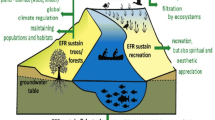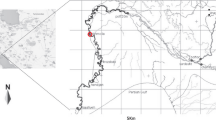Abstract
This paper focuses on the environmental flow assessment (EFA) methods that maintain the river ecosystem and its integrity for hydropower plants (HPP) with their implementations on a run-off river type HPP. EFA is a crucial phenomenon in terms of electricity production and sustaining river integrity simultaneously. The novelty of this study is that it consists both a comparison of widely used preferred EFA methods and a detailed investigation of the river with pre and post-dam flow regimes. The research shows that by expanding the content and scope of the methods, their relative reliabilities increase. However, this situation requires much more expert, money, and time. Apart from most of the relevant literature, pre and post-dam situations are investigated with a flow duration curve (FDC). It is concluded that the dramatic difference between the flow characteristics of pre and post-dam situations affects long-term aquatic life. Furthermore, a case study is conducted using the selected hydrological flow assessment methods, Tennant and Tessman methods, and comparisons are made. The calculated flows are compared with monthly average flow values before dam construction, projected environmental flow data, and the current situation. Accordingly, Tennant’s “good classification” is proposed to determine the environmental flow (EF) for the considered case study.





Similar content being viewed by others
References
Acreman, M., & Dunbar, M. J. (2004). Defining environmental river flow requirements- a review. Hydrology and Earth System Sciences, 8, 861–876.
Alcázar, J., & Antoni, P. (2010). Establishing environmental flow regimes in a Mediterranean watershed based on a regional classification. Journal of Hydrology, 388(1–2), 41–51.
Annear, T. I., Chisholm, H., Beecher, A., Locke, P., Aarrestad, C., & Coomer, C. (2004). Instream flows for riverine resource stewardship, Revised Edition. Cheyenne: Instream Flow Council.
Arthington, A. H. (2012). Freshwater ecology series, volume 4: Environmental flows: saving rivers in the third millennium. Berkeley: University of California Press.
Arthington, A. H., Rall, J. L., Kennarda, M. J., & Pusey, B. (2003a). Environmental flow requirements of fish in Lesotho rivers using the drift methodology. River Research and Applications, 19, 641–666.
Arthington, A. H., Tharme, R. E., Brizga, S. O., Pusey, B. J., & Kennard, M. J. (2003b). Environmental flow assessment with emphasis on holistic methodologies. In: Proceedings of the second international symposium on the management of large rivers for fisheries, (pp. 11–14) Phnom Penh: Kingdom of Cambodia.
Babel, M. S., Dinh, C. N., Mullick, M. R. A., & Nanduri, U. V. (2012). Operation of a hydropower system considering environmental flow requirements: a case study in La Nga river basin, Vietnam. Journal of Hydro-Environment Research, 6(1), 63–73.
Botelhoa, A., Ferreira, P., Lima, F., Costa, P. L. M., & Sousa, S. (2017). Assessment of the environmental impacts associated with hydropower. Renewable and Sustainable Energy Reviews, 70, 896–904.
Bovee, K. D., Lamb, B.L., Bartholow, J. M., Stalnaker, C. B., Taylor, J. & Henriksen, J. (1998). Stream habitat analysis using the instream flow incremental methodology. https://www.fort.usgs.gov/sites/default/files/products/publications/3910/3910.pdf. Accessed 06 Aug 2016.
Caissie, D., El-Jabi, N., & Hebert, C. (2007). Comparison of hydrologically based instream flow methods using a resampling technique. Canadian Journal of Civil Engineering, 34, 66–74.
Cioffi, F., & Gallerano, F. (2012). Multi-objective analysis of dam release flows in rivers downstream from hydropower reservoirs. Applied Mathematical Modelling, 36(7), 2868–2889.
Dincer, I. (1998). Energy and environmental impacts: present and future perspectives. Energy Sources, 20(4–5), 427–453.
Dincer, I. (1999). Environmental impacts of energy. Energy Policy, 27(14), 845–854.
Dincer, I. (2000). Renewable energy and sustainable development: a crucial review. Renewable and Sustainable Energy Reviews, 4(2), 157–175.
Dincer, I. (2003). On energy conservation policies and implementation practices. International Journal of Energy Research, 27(7), 687–702.
Dyson, M., Bergkamp, G., & Scanlon, J. (2003). Flow: the essentials of environmental flows. https://cmsdata.iucn.org/downloads/flow___the_essentials_of_environmental_flow___dyson_et_al.pdf. Accessed 20 Oct 2016.
Fang, Y., Wang, M., Deng, W., & Xu, K. (2010). Exploitation scale of hydropower based on instream flow requirements: a case from southwest China. Renewable and Sustainable Energy Reviews, 14, 2290–2297.
Gippel, C. J., & Stewardson, M. J. (1998). Use of wetted perimeter in defining minimum environmental flows. Regulated Rivers: Research & Management, 14, 53–67.
Gopal, B. (2013). Methodologies for the assessment of environmental flows, Environmental Flows. http://www.aquaticecosystems.org/wp-content/uploads/2014/02/EFlow-Prelims.pdf. Accessed 15 May 2016.
Gupta, A. D. (2008). Implication of environmental flows in river basin management. Physics and Chemistry of the Earth, 33, 298–303.
Hatfield, T., Wright, N., Buchanan, S. & Faulkner, S. A. (2013). Review of environmental flow assessment methods for application to northeastern British Columbia. https://www.for.gov.bc.ca/het/climate/knowledge/PDFs%202015/FinalWaterAllocationReport_150331.pdf. Accessed 24 April 2016.
Hu, W. W., Wang, G. X., Deng, W., & Li, S. N. (2008). The influence of dams on ecohydrological conditions in the Huaihe River basin, China. Ecological Engineering, 33(3), 233–241.
Jager, H. I., & Smith, B. T. (2008). Sustainable reservoir operation: can we generate hydropower and preserve ecosystem values? River Research and Applications, 24, 340–352.
Jowett, I. G. (1997). Instream flow methods: a comparison of approaches. Regulated Rivers: Research & Management, 13, 115–127.
Karakoyun, Y., Yumurtaci, Z., & Dönmez, A. H. (2016). Environmental flow assessment for energy generation sustainability employing different hydraulic evaluation methods: Çambaşi hydropower plant case study in Turkey. Clean Technologies and Environmental Policy, 18(2), 583–591.
King, J., & Brown, C. (2003). Environmental flows: concepts and methods. In Water Resources and Environment Technical Note C.1. http://documents.worldbank.org/curated/en/828931468315285821/pdf/263200NWP0REPL1Concepts0and0Methods.pdf. Accessed 13 May 2017.
King, J. M., & Brown, C. A. (2006). Environmental flows: striking the balance between development and resource protection. Ecology and Society, 11, 2–26.
King, J., & Louw, D. (1998). Instream flow assessments for regulated rivers in South Africa using the building block methodology. Aquatic Ecosystem Health & Management, 1, 109–124.
King, J., Brown, C., & Sabet, H. (2003). A scenario-based holistic approach to environmental flow assessments for rivers. River Research and Applications, 19(5–6), 619–639.
King, J. M., Tharme, R. E., & De Villiers, M. S. (2008). Environmental flow assessments for rivers: manual for the building block methodology (updated edition). http://www.wrc.org.za/Knowledge%20Hub%20Documents/Research%20Reports/TT%20354-CONSERVATION.pdf. Accessed 13 Sept 2016.
Kumar, P., Chaube, U. C., & Mishra, S. K. (2007). Environmental flows for hydropower projects – a case study. http://www.ahec.org.in/links/International%20conference%20on%20SHP%20Kandy%20Srilanka%20All%20Details%5CPapers%5CEnvironmentsal%20Aspects-B%5CB1.pdf. Accessed 10 July 2016.
Linnansaari, T., Monk, W. A., Baird, D. J., & Curry, R. A. (2013). Review of approaches and methods to assess environmental flows across Canada and internationally. http://www.dfo-mpo.gc.ca/library/348885.pdf. Accessed 23 June 2016.
Liu, C., Zhao, C., Xia, J., Sun, C., Wang, R., & Liu, T. (2011). An instream ecological flow method for data-scarce regulated rivers. Journal of Hydrology, 398(1), 17–25.
Magilligan, F. J., & Keith, H. N. (2005). Changes in hydrologic regime by dams. Geomorphology, 71(1), 61–78.
Mazvimavi, D., Madamombe, E., & Makurira, H. (2007). Assessment of environmental flow requirements for river basin planning in Zimbabwe. Physics and Chemistry of the Earth, 32(15), 995–1006.
Moore, M. (2005). Perceptions and interpretations of environmental flows and implications for future water resources management-a survey study. http://liu.diva-portal.org/smash/get/diva2:19900/FULLTEXT01. Accessed 16 June 2016.
O’Keeffe, J., & Le Quense, T. (2009). Keeping rivers alive: a primer on environmental flows and their assessment. http://assets.wwf.org.uk/downloads/keeping_rivers_alive.pdf. Accessed 14 Sept 2016.
Operacz, A., Wałęga, A., Cupak, A., & Tomaszewska, B. (2018). The comparison of environmental flow assessment-the barrier for investment in Poland or river protection? Journal of Cleaner Production, 193, 575–592.
Parker, G. W., Armstrong, D. S., & Richards, T. A. (2004). Comparison of methods for determining streamflow requirements for aquatic habitat protection at selected sites on the Assabet and Charles Rivers, eastern Massachusetts, 2000–02. US Department of the Interior, US Geological Survey.
Pastor, A. V., Ludwig, F., Biemans, H., Hoff, H., & Kabat, P. (2014). Accounting for environmental flow requirements in global water assessments. Hydrology and Earth System Sciences, 8, 5041–5059.
Piman, T., Cochrane, T. A., & Arias, M. (2016). Effect of proposed large dams on water flows and hydropower production in the Sekong, Sesan and Srepok rivers of the Mekong Basin. River Research and Applications, 32, 2095–2108.
Project information file of Feke I regulator and hydropower plant project (2009). Technical Paper.
Pyrce, R. (2004). Hydrological low flow indices and their uses. In Watershed Science Centre. http://www.csp.trentu.ca/iws/documents/LowFlowOntRpt2004.pdf. Accessed 28 July 2016.
Reinfelds, I., Haeusler, T., Brooks, A. J., & Williams, S. (2004). Refinement of the wetted perimeter breakpoint method for setting cease-to-pump limits or minimum environmental flows. River Research and Applications, 20(6), 671–685.
Republic of Turkey Prime Ministery (2016). http://www.mevzuat.gov.tr/Metin.Aspx?MevzuatKod=7.5.20546& [in Turkish]. Accessed 23 April 2017.
Smakhtin, V. U. (2001). Low flow hydrology: a review. Journal of hydrology, 240(3-4), 147–186.
Smakhtin, V., & Anputhas, M. (2006). An assessment of environmental flow requirements of Indian river basins. http://dlc.dlib.indiana.edu/dlc/bitstream/handle/10535/4063/RR107%5B1%5D.pdf?sequence=1>. Accessed 15 July 2016.
Smakhtin, V. U., & Eriyagama, N. (2008). Developing a software package for global desktop assessment of environmental flows. Environmental Modelling & Software, 23(12), 1396–1406.
Smakhtin, V., Revenga, C., & Döll, P. (2004). A pilot global assessment of environmental water requirements and scarcity. Water International, 29, 307–317.
Smakhtin, U., Shilpakar, R. L., & Hughes, D. A. (2006). Hydrology-based assessment of environmental flows: an example from Nepal. Hydrological Sciences Journal, 51(2), 207–222.
Sun, T., Yang, Z. F., Shen, Z. Y., & Zhao, R. (2009). Environmental flows for the Yangtze Estuary based on salinity objectives. Communications in Nonlinear Science and Numerical Simulation, 14(3), 959–971.
Sun, T., Xu, J., & Yang, Z. F. (2013). Environmental flow assessment in estuaries based on an integrated multi-objective method. Hydrology and Earth System Sciences, 17, 751–760.
Tennant, D. L. (1976). Instream flow regimens for fish, wildlife, recreation and related environmental resources. Fisheries, 1(4), 6–10.
Tharme, R. (2003). A global perspective on environmental flow assessment: emerging trends in the development and application of environmental flow methodologies for rivers. River Research and Applications, 19, 397–441.
Tharme, R. E., & King, J. M. (1998). Development of the building block methodology for instream flow assessments, and supporting research on the effects of different magnitude flows on riverine ecosystems. In Water Research Commission Report No. 576/1/98.
The Brisbane Declaration (2007). Environmental flows are essential for freshwater ecosystem health and human well-being. http://www.watercentre.org/news/declaration. Accessed 13 July 2017.
Walega, A., Mlynski, D., Kokoszka, R., & Miernik, W. (2015). Possibilities of applying hydrological methods for determining environmental flows in select catchments of the upper Dunajec Basin. Polish Journal of Environmental Studies, 24(6), 2663–2676.
Yang, F., Xia, Z., Yu, L., & Guo, L. (2012). Calculation and analysis of the instream ecological flow for the Irtysh River. Procedia Engineering, 28, 438–441.
Author information
Authors and Affiliations
Corresponding author
Additional information
Publisher’s Note
Springer Nature remains neutral with regard to jurisdictional claims in published maps and institutional affiliations.
Rights and permissions
About this article
Cite this article
Karakoyun, Y., Dönmez, A.H. & Yumurtacı, Z. Comparison of environmental flow assessment methods with a case study on a runoff river–type hydropower plant using hydrological methods. Environ Monit Assess 190, 722 (2018). https://doi.org/10.1007/s10661-018-7107-3
Received:
Accepted:
Published:
DOI: https://doi.org/10.1007/s10661-018-7107-3




